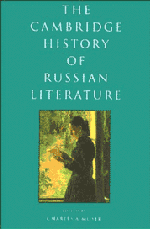Book contents
- Frontmatter
- 1 The literature of old Russia, 988–1730
- 2 The eighteenth century: neoclassicism and the Enlightenment, 1730–90
- 3 The transition to the modern age: sentimentalism and preromanticism, 1790–1820
- 4 The nineteenth century: romanticism, 1820–40
- 5 The nineteenth century: the natural school and its aftermath, 1840–55
- 6 The nineteenth century: the age of realism, 1855–80
- 7 The nineteenth century: between realism and modernism, 1880–95
- 8 Turn of a century: modernism, 1895–1925
- 9 The twentieth century: the era of socialist realism, 1925–53
- 10 The twentieth century: in search of new ways, 1953–80
- 11 Afterword: Russian literature in the 1980s
- Bibliography
6 - The nineteenth century: the age of realism, 1855–80
Published online by Cambridge University Press: 28 March 2008
- Frontmatter
- 1 The literature of old Russia, 988–1730
- 2 The eighteenth century: neoclassicism and the Enlightenment, 1730–90
- 3 The transition to the modern age: sentimentalism and preromanticism, 1790–1820
- 4 The nineteenth century: romanticism, 1820–40
- 5 The nineteenth century: the natural school and its aftermath, 1840–55
- 6 The nineteenth century: the age of realism, 1855–80
- 7 The nineteenth century: between realism and modernism, 1880–95
- 8 Turn of a century: modernism, 1895–1925
- 9 The twentieth century: the era of socialist realism, 1925–53
- 10 The twentieth century: in search of new ways, 1953–80
- 11 Afterword: Russian literature in the 1980s
- Bibliography
Summary
The zenith of Russian realistic prose is treated here as beginning in 1855, a date of political significance, the year in which Nicholas I passed from the scene, but also of literary importance, as the year which saw the publication of Chernyshevsky’s Esthetic Relations of Art to Reality. That essay formulated the principles upon which literary critics, by then quite numerous, would judge and interpret the literary masterpieces shortly to be produced. Chernyshevsky’s was a straight-forwardly materialist esthetic, based on the central propositions that “the beautiful is life” and that art is in every meaningful sense inferior to a reality subject to rational comprehension. His critical followers elaborated upon his ideas with such enthusiasm that by 1865 his doctrine had become the dominant critical view. Even those numerous critics and even more numerous writers who rejected Chernyshevsky’s approach had to take it into serious account, and in this sense his ideas defined the course of the literary discussion in large measure until about 1870.
The years from 1855 to 1880 were the time when the Russian realists flourished. A mere listing of names is sufficient to make the point: Dostoevsky, Tolstoy, Turgenev, Goncharov, Saltykov-Shchedrin, Pisemsky, Ostrovsky, Leskov – the literary careers of all these reached their peak during this quarter-century. It was also a stimulating period for criticism, with critics of sufficient stature at least to compare with the writers they interpreted: Chernyshevsky, Dobrolyubov and Pisarev among the radicals, Grigorev among their opponents.
- Type
- Chapter
- Information
- The Cambridge History of Russian Literature , pp. 248 - 332Publisher: Cambridge University PressPrint publication year: 1992
- 2
- Cited by



